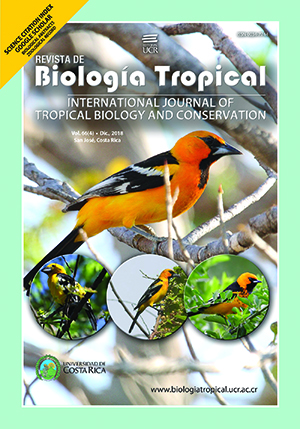Abstract
For accurate determination of polleniferous taxa vis-a-vis floral fidelity of Apis mellifera L. in North 24 Pargana, West Bengal, we carried out pollen analyses of individual corbicular pollen loads collected from four apiaries during 2015-2016. Among the 2 434 analyzed loads, 72.97 % were unifloral type, 19.0 % bifloral and 8.10 % were multifloral in pollen composition. We identified 43 different types of palynomorphs belonged to 28 botanical families. Major polleniferous plant species include: Alangium salviifolium, Borassus flabellifer, Brassica nigra, Coriandrum sativum, Croton bonplandianum, Cyanotis axillaris, Luffa cylindrica, Neolamarckia cadamba, Phoenix sylvestris, Poa gangetica, Sesamum indicum and Trema orientalis. Among them, T. orientalis is newly reported from West Bengal especially during June to August (monsoon season). The plant family provided maximum number of loads was Arecaceae (20.91 %), followed by Brassicaceae (16.2 %), Poaceae (6.70 %), Pedaliaceae (6.38 %), Apiaceae (6.16 %) and Fabaceae (5.38 %). Month wise highest number of pollen diversity were obtained during March (13 pollen types) and a minimum of 6 types in November. The present investigation will help the beekeepers to maintain their hives in the region for sustainable apicultural practices.
References
Alfonsus, E. O. (1933). Zum Pollenverbrauch des Bienenvolkes. Archivfur Bienenkunde, 14, 220-223.
Alves, R. F., & Santos, F. A. R. (2014). Plant sources for bee pollen load production in Sergipe, northeast Brazil. Palynology, 38(1), 90-100.
Diaz-Losada, E., Ricciardelli-d’Albore, G., & Saa-Otero, M. P. (1998). The possible use of honeybee pollen loads in characterising vegetation. Grana, 37, 155-163.
Dietz, A. (1975). Nutrition of the adult honeybee. In Dadant & Sons (Eds.), The Hive and the Honey Bee (pp. 125-156). Hamilton, IL: Dadant and Sons.
Dórea, M. C., Novais, J. S., & Santos, F. A. R. (2010). Botanical profile of bee pollen from the southern coastal region of Bahia, Brazil. Nota Cientifica. Acta Botanica Brasilica, 24(3), 862-867.
Erdtman, G. (1960). The acetolysis method. A revised description. Svensk Botanisk Tidskrift, 54, 561-564.
Freitas, A. D. S. D., Sattler, J. A. G., Souza, B. R. D., Almeida-Muradian, L. B., Sattler, A., & Barth, O. M. (2015). A melissopalynological analysis of Apis mellifera L. loads of dried bee pollen in the southern Brazilian macro-region. Grana, 54(4), 305-312.
Haydak, M. H. (1935). Brood rearing by honeybees confined to pure carbohydrate diet. Journal of Economic Entomology, 29, 657-660.
Jones, G. D., & Bryant, V. M. Jr. (2004). The use of ETOH for the dilution of honey. Grana, 43, 174-182.
Karmakar, P., Layek, U., & Pal, P. K. (2011). Sesamum indicum L., a potential bee plant in Bankura and Paschim Medinipur district, West Bengal. Journal of the Botanical Society of Bengal, 65(1), 69-74.
Layek, U., Bhakat, R. K., & Karmakar, P. (2015). Foraging behaviour of Apis florea Fabricius during winter and spring-summer in Bankura and Paschim Medinipur districts, West Bengal. Global Journal of Bio Sciences and Biotechnology, 4(3), 255-263.
Layek, U., & Karmakar, P. (2016). Bee plants used as nectar sources by Apis florea Fabricius in Bankura and Paschim Medinipur districts,West Bengal. Geophytology, 46(1), 1-14.
Layek, U., & Karmakar, P. (2018). Pollen analysis of Apis dorsata Fabricius honeys in Bankura and Paschim Medinipur districts, West Bengal. Grana. 57(4), 298-310. DOI: 10.1080/00173134.2017.1390604.
Layek, U., Nandi, T., & Karmakar, P. (2016). Pollen forage and storage pattern of Apis dorsata Fabricius in Bankura and Paschim Medinipur districts, West Bengal. International Journal of Pure and Applied Bioscience, 4(5), 59-71.
Lopez, J. M. V., Vives, L. G., & Boi, M. (2013). Estimation of the polleniferous potential of a Mediterranean landscape through the analysis of pollen harvested by Apis mellifera L. Grana, 52(2), 147-159.
Marchini, L. C., Reis, V. D. A., & Moreti, A. C. C. C. (2006). Composicao fisico-quimica de amostras de pollen coletado por abelhas africanizadas Apis mellifera (Hymenoptera: Apidae) em Piracicaba, Estado de Sao Paulo. Ciencia Rural, 36(3), 949-953.
Modro, F. H. A., Silva, C. I., Cynthia, F. P., Luz, F. P. C., & Message, D. (2009). Analysis of pollen load based on color, physicochemical composition and botanical source. Anais da Academia Brasileira de Ciências, 81(2), 281-285.
More, S., Ghorai, N., & Bera, S. (2010). Study on the selection of some local pollen plants in West Bengal, India as pollen brood feed in Apis cerana Fabr. larvae by the worker bees, through Meconia analysis and community ordination method of recovered pollen taxa. Proceedings of the Zoological Society, 63(1), 39-44.
Nayar, T. S. (1990). Pollen flora of Maharashtra state, India. International Bioscience Series, 14.
Noor, M. J., Khan, M. A., & Camphor, E. S. (2009). Palynological analysis of pollen loads from pollen sources of Honeybees in Islamabad, Pakistan. Pakistan Journal of Botany, 41(2), 495-501.
Ohe, W. V. D., Oddo, L. P., Piana, M. L., Morlot, M., & Martin, P. (2004). Harmonized methods of melissopalynology. Apidologie, 35, 18-25. DOI: 10.1051/apido:2004050
Pal, P. K., & Karmakar, P. (2013). Pollen analysis in understanding the foraging behaviour of Apis mellifera in Gangetic West Bengal. Geophytology, 42(2), 93-114.
Saavedra-Carhuatacto, D. M., Aguinago-Castro, F., Rojas-Indrogo, C., & Delgado-Paredes, G. E. (2014). Analysis of pollen loads collected by honey bees (Apis mellifera L.) from Lambayeque Province (Peru): botanical origin and protein content. Journal of Global Biosciences, 3(1), 285-298.
Sajwani, A., Farooq, S. A., & Bryant, V. M. (2014). Studies of bee foraging plants and analysis of pollen pellets from hives in Oman. Palynology, 38(2), 207-223.
Suryanarayana, M. C., Rao, G. M., & Singh, T. S. M. S. (1992). Studies on pollen sources for Apis cerana Fabr and Apis mellifera L bees at Muzaffarpur, Bihar, India. Apidologie, 23, 33-46.
Thorp, W. R. (2000). The collection of pollen by bees (Apoidea). Plant Systematic and Evolution, 222, 211-223.
##plugins.facebook.comentarios##

This work is licensed under a Creative Commons Attribution 4.0 International License.
Copyright (c) 2018 Revista de Biología Tropical






